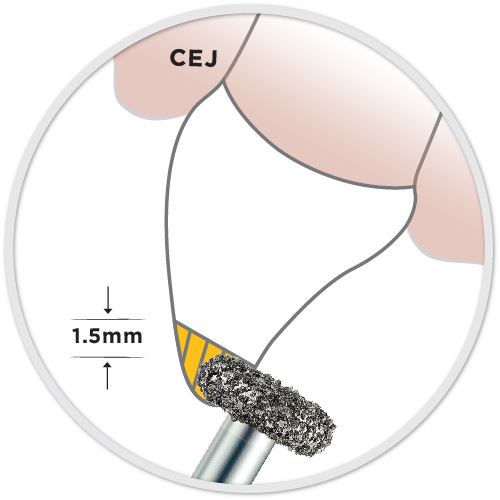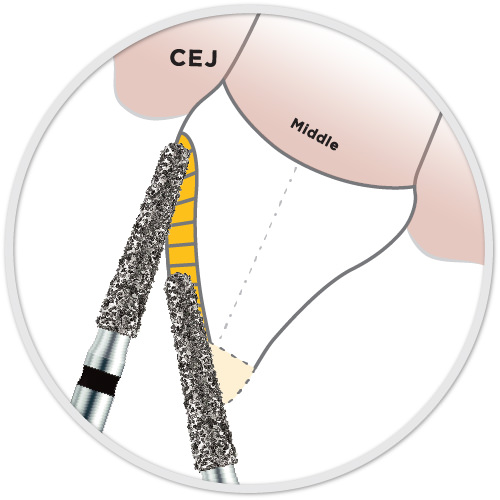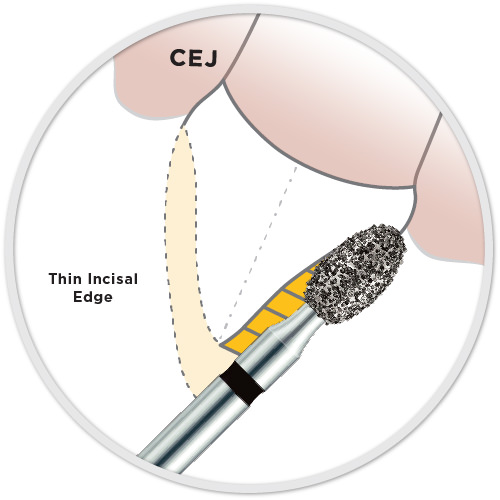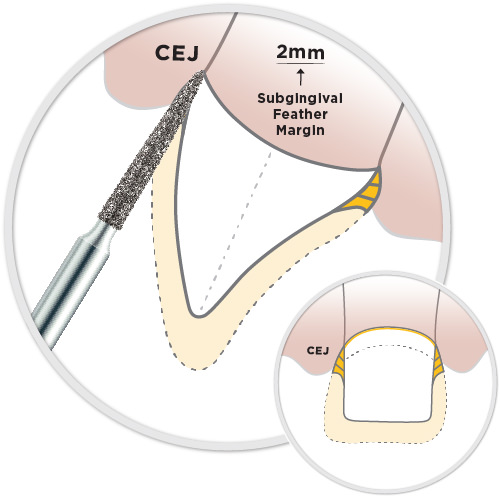1(a) Prep mesial half of the incisal edge to the COMPLETE thickness (1.5mm) of the EZPrep 001 donut bur.
1(b) Prep and blend the distal half of the incisal edge to create a uniform incisal reduction.
To compensate for eruption of the clinical crown during development in patients less than three years old, additional incisal reduction up to 2mm may be needed.

2(a) Keeping the bur parallel to the long axis of the tooth, create a chamfer margin at the gum line at least half the thickness of the bur tip. This axial depth cut, when extended around the entire circumference of the tooth, will automatically create the right amount of axial reduction elsewhere (0.5—1.0mm)—about half the thickness of the EZPrep 002 chamfer bur.
2(b) After the axial reduction is finished, go back and taper the incisal half lingually to create a thin incisal edge. Do not taper interproximally! (Pulp Horns)
To prevent your crown from being labially inclined, adequate reduction in BOTH facial planes is critical. Viewing the prep from the incisal, make sure that the facial-incisal edge is behind the facial plane of the adjacent tooth.

3(a) Remove the cingulum and 0.75—1.25mm of lingual enamel and blend together forming a smooth, slightly concave surface extending all the way to the tissue.
3(b) After the lingual reduction is finished, go back and thin the incisal half, creating a thin incisal edge.
While aggressive lingual reduction is not necessary to seat the crown after this step, the lingual surface of the prep should appear concave and extend all the way from the incisal edge to the tissue.

A chamfer margin the thickness of the EZPrep 002 chamfer bur must be visible at the tissue level all the way around the tooth. This is your Axial Depth Cut. If this margin is not visible, go back and repeat Step 2 and step 3.
A straight, thin incisal edge must be visible. If a straight, thin incisal edge is not visible, go back and repeat step 2(b) and step 3(b).
4(a) With the EZPrep 004 flame bur, remove the chamfer margin at the tissue level. Keep the bur parallel to the long axis of the tooth. Remove the chamfer in incremental steps, beginning 0.5mm subgingivally and going slightly more subgingivally with each pass. This will minimize trauma to the tissue, reducing gingival bleeding.
4(b) Once the chamfer margin is gone, extend the tip of the bur the full 2mm subgingivally. While hugging the bur axially along the root surface, make three circumferential passes. All of the chamfer margin should be gone, leaving a smooth transition from the root, past the CEJ, to the coronal tooth.
The labial bulge must be completely removed to allow for a passive fit. In younger patients, this tooth structure may be hiding below the tissue line. Therefore, it is essential to extend the tip of the EZPrep 004 bur 1.5mm subgingivally.

All of the chamfer margin should be gone, leaving a smooth transition from the root, past the CEJ, to the coronal tooth. Verify completion of this step by using an explorer (or EZPREP 004 diamond bur tip) going from root to tooth ALL the way around the preparation. If any chamfer or buccal bulge remains, go back and remove them with the EZPREP 004 flame bur.